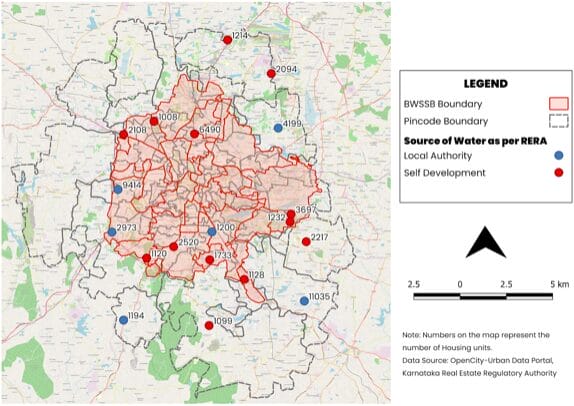Within just a few decades, Bengaluru has grown into the third largest city and the fifth largest metropolitan area of the country, with over 13 million people. The city’s rapid development is evident in the rise of built-up area, which has increased 37.4% in 2002 to 93.3% in 2020. In just 40 years, the extent of water bodies has reduced from 3.4% (1973) to less than 1% (2013), placing Bengaluru’s water resources under tremendous stress.
Consequently, the city has come to depend heavily on Cauvery water and private water tankers or individual borewells to meet its daily demand. The overexploitation of groundwater is particularly concerning, especially in the context of the water crisis that is currently plaguing some parts of the city.
Read more: Water shortage in Bengaluru: Families, schools, hospitals share their struggle

Tracing water consumption patterns in real estate development
While analysing water consumption in the city, it is important to shine the spotlight on what patterns of real estate development tell us about current as well as future water demands. We decided to probe this further in the datajam conducted by OpenCity.in, held last month. .
Real estate projects are regulated by The Karnataka Real Estate Regulatory Authority (K-RERA), constituted under the RERA Act of 2016. The Act is meant to help homeowners by ensuring transparency and accountability among developers. The Government of Karnataka’s RERA website functions as a repository of all the real estate projects that have been approved or are pending approval by RERA.
Recently, it was notified that all real estate projects must declare their water sources and obtain a No Objection Certificate (NOC) from either the Bangalore Water Supply and Sewerage Board (BWSSB) or the relevant local authority. This additional piece of information allows us to understand the water consumption patterns of new and upcoming projects in the city.
For our study, we scraped project details from the K-RERA website and looked at the self-reported information on water sources. From the longlist, we chose to focus on projects that have over 1,000 units since they are likely to have a high water demand.
Out of 19 privately developed projects plotted from our sample of K-RERA, 13 reported ‘self-development’ as their main water source, indicating reliance on borewell and groundwater through private tankers. The remaining six, particularly those outside the BWSSB limits, listed their water source as the relevant ‘local authority’, indicating that their water source may be a mix of groundwater and surface water bodies. Surprisingly, none of the projects reported BWSSB as their water source, despite many of them being within the BWSSB boundary.

Read more: Utilise treated wastewater: Bengaluru’s first water balance report
Way forward for K-RERA
While the mandate to disclose water sources is a welcome move, it needs to be made more transparent and stringent. Since water availability and requirement is not straightforward, it must be assumed that water consumption and use practices will also be complicated. Categories like ‘self-development’ and ‘local authority’ do not allow us to understand the reality of water consumption patterns in these large projects.
The data reveals an overdependence on groundwater and private water tankers as the primary source of water. Large projects are high water consumers and their presence can further exacerbate the water scarcity situation the city is currently facing.
Further, there is a need to expand RERA regulations to waste water disposal. While the BWSSB mandates STP plants for all apartments above 120 units this is rarely implemented in practice, leading to rampant mismanagement and pollution of water bodies in the city. RERA provides an opportunity to integrate the fragmented water governance landscape.
Information reported by bodies like RERA will be critical in planning and creating resilient water infrastructure for the city. However, the data must be standardised and captured in as much detail as possible in order to be truly useful.